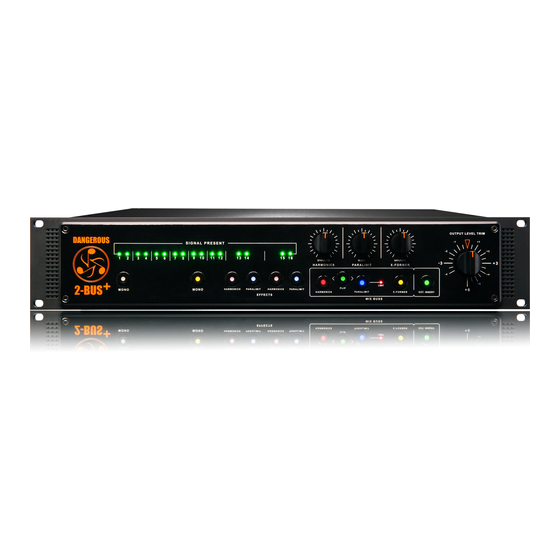Dangerous Music 2-BUS+ User Manual - Page 6
Browse online or download pdf User Manual for Music Mixer Dangerous Music 2-BUS+. Dangerous Music 2-BUS+ 20 pages. 16-channel analog summing mixer with both xlr and db-25 inputs

| DANGEROUS MUSIC
2
2-BUS + : Quickstart Guide
UNPACK AND POWER UP
Remove the 2-BUS+ from the box along with the included IEC power cable and plug the unit into AC mains power.
Turn on the power switch next to the AC cable socket on the back and confirm that the unit has powered up by checking that
the front panel LEDs are illuminated.
Turn the unit off.
CONNECT THE 2-BUS+ TO YOUR STUDIO
Using high quality cables, connect the outputs of your digital-to-analog converter to either the XLR or DB-25 connectors on the
back of the 2-BUS+.
Connect the stereo MONITOR OUTS to a balanced input on your monitor controller. Do not hook the 2-BUS+ directly to
speakers. Excellent monitor controller options include The Dangerous SOURCE, D-BOX or MONITOR ST.
Connect the stereo MAIN OUTS to whatever your final print path will be (back into your DAW Interface, 2-Channel A/D converter
or to an external digital or analog 2-track recorder).
TIP: If you're using a patch bay, make the same connections according to your bay's routing. Be sure to use high quality patch
bays and cables to assure the best connections for all the gear in your studio.
ZERO OUT THE 2-BUS+
Power up the 2-BUS+.
Set the Attenuator to the 12 o'clock position (orange triangle).
Disengage the Harmonics, Paralimit, and X-Former buttons (light dim) and turn their knobs fully counter-clockwise.
Make sure the EXT. INSERT is disengaged (light dim).
STEM OUT A MIX AND MAKE SOME SOUND
Assign track outputs or groups of track outputs (called "stems") from your DAW to the channels you want them to occupy on
the 2-BUS+. You might send all the drums out in stereo on channels 3-4, guitars on 5-6, etc...
Assign mono tracks from the DAW that you'd like to have in the middle of your mix (perhaps bass and lead vocals) to channels
1-2 or 9-10 and then engage the MONO buttons to bring those channels to the center of the mix.
Press play and use your DAW to get a basic mix happening. Enjoy mixing in analog!
TIP: Don't overthink the routing. Just remember that sounds with loud transients should be spread out to take the stress off the
DAW. Remember, there's no one right way to organize a mix. Every project is unique, and even different genres of music call for
different approaches. Organizing the routing in effective ways is part of the craft of analog mixing. See our website or read the
rest of this manual for routing examples, diagrams and helpful tips.
START MIXES IN THE ANALOG ENVIRONMENT
Analog and digital mixing environments are very different, and what worked "in the box" might not hold up once it's being
summed in analog. Ultimately you'll get far better results in analog, but if you need to rework a pre-existing digital mix, we
recommend zeroing out the mix, removing the plug-ins and starting from scratch.
Begin all new mixing projects through the 2-BUS+ (Create a template in your DAW). That way you wont have to re-do anything
